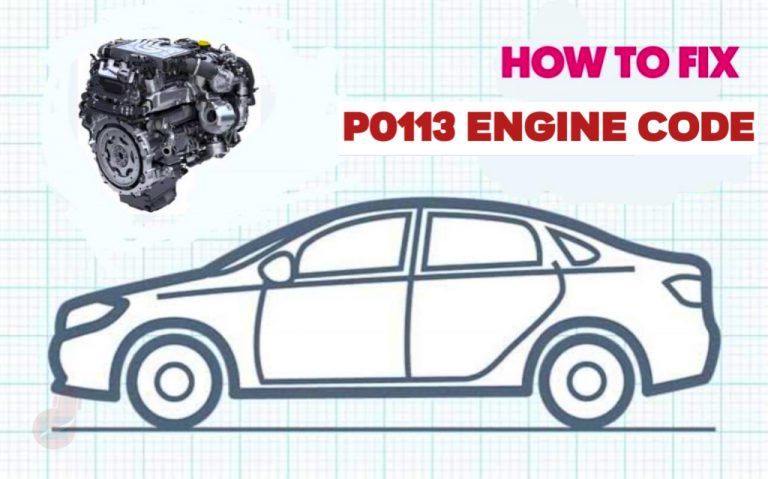What Does Code P0113 Mean?
P0113 Meaning: The Intake Air Temperature (IAT) Sensor Circuit High Input Problem is a generic diagnostic trouble code (DTC) in the OBD-II system.
The Engine Control Module (ECM) or Powertrain Control Module (PCM) is responsible for monitoring the temperature of the air entering the engine to ensure the appropriate air-fuel mixture. This mixture provides enough oxygen to the engine to burn fuel effectively, with too little or too much air causing harm to the engine.
To avoid this harm, the PCM uses an Intake Air Temperature (IAT) sensor to monitor the air-fuel mixture.
The IAT sensor is a thermistor that varies its resistance based on the temperature of the air entering the engine. The thermistor’s resistance decreases as the air temperature increases, while cooler temperatures result in higher resistance.
The PCM sends a 5-volt voltage to the IAT sensor.
If the PCM receives a signal voltage greater than 5 volts from the air temperature sensor, there may be a problem with Air Intake Sensor 1 or its circuit.
As a result, the PCM logs the P0113 code and illuminates the check engine light.
P0113 Causes
There are several potential causes of code P0113:
- A dirty air filter
- A faulty PCM or ECM
- A damaged intake air temperature sensor (IAT sensor)
- A faulty mass air flow sensor (MAF sensor)
- A faulty IAT sensor connector
- An open IAT ground circuit or signal circuit
- A shorted IAT signal circuit
- The IAT sensor wiring network is passed too close to a high voltage wiring (like a spark plug wire or alternator)
P0113 Symptoms
There are several symptoms of p0113, depending on your vehicle manufacturer or engine type.
These are some of the common symptoms of P0113
- Check Engine Light
- Trouble starting the engine
- Engine running lean
P0113 Diagnosis
The trouble code P0113 is a generic OBD-II code that applies to vehicles equipped with the On-Board Diagnostics II system.
It is not recommended to diagnose the problem yourself, as it requires professional knowledge.
A trained mechanic will use an OBD-II scanner to retrieve the stored code and review the freeze frame data to determine the trigger conditions.
After analyzing the data, the mechanic will clear the fault code and take the vehicle for a test drive to see if the check engine light reappears and the code returns.
If the code reappears, the mechanic will visually inspect the wiring harness between the temperature sensor and the PCM, check the connector to the sensor, and search for any open circuit.
They may use an infrared thermometer to compare the intake air temperature with the coolant temperature when the engine is warm.
Additionally, the mechanic may remove the sensor from the IAT connector and use a multimeter to test the resistance of the air temperature sensor.
They can check if the resistance decreases by applying heat to the IAT sensor tip. If the resistance reading remains the same, the IAT sensor is defective and needs to be replaced.
If no issues are found in the above steps, the mechanic may need to inspect the PCM or ECM for malfunctions.
P0113 Error Code – FIX
If your vehicle’s IAT sensor is the leading cause of the P0113 code, it is essential to get it diagnosed by a trusted professional to determine the root cause of the problem. Attempting to diagnose the issue at home may not yield the desired results.
Taking your vehicle to a reliable mechanic shop is advisable if you have the P0113 code and are not confident in diagnosing the issue. Professional mechanics can quickly identify the problem and offer a minimum 12-month, 12,000-mile warranty on their work and fair pricing.
How Much Does It Cost to Fix Code P0113?
It is essential to know the cost of fixing the P0113 code so that you can plan and pay before you begin fixing the P0113 code.
You need to know that you can’t know the cost of fixing your P0113 code until there is a proper and accurate diagnosis first.
Immediately after, identifying the major cause, then your mechanic may discover the issue. Your mechanic may discover any of the issues below.
Wiring or connector issues: If the major problem is the wiring and the connector for the IAT sensor or if there’s any short circuit, then you need to replace the faulty wire or connector.
Temperature sensor issues: if the major problem of your P0113 code is a temperature sensor issue, then your mechanic needs to fix any fault in the temperature sensor. You will pay for cleaning, adjustment of the sensor and its ground, or replace the sensor if it’s too damaged.
Air filter issues: If the air filter is the primary cause of your P0113 code, it is a dirty or damaged air filter; you need to pay your mechanic to clean or replace it to ensure good air intake.
MAF sensor issues: The mass air flow sensor and MAF connector may be at fault, and it causes the P0113 code. In this case, your mechanic must inspect the MAF sensor and its connector and replace them if necessary.
PCM issues: Your mechanic will test and replace the PCM if necessary.
These are estimated repair costs for some of the fixes below.
- Air intake temperature sensor replacement cost: $87 to $96
- Air filter replacement cost: $40 to $85
- MAF sensor replacement cost: $80 to $380
- PCM replacement cost: $800 to $1,500.
In Conclusion
It is crucial to address the P0113 code promptly to prevent damage to the emission system and catalytic converter.
While it may be possible to operate a vehicle with a P0113 code for a brief period, avoiding prolonged driving with this code is strongly recommended. This will help prevent internal engine damage.
As an Amazon Service LLC Program Associate, V. Auto Basics earns from qualifying purchases. See Our Affiliate disclaimer.
